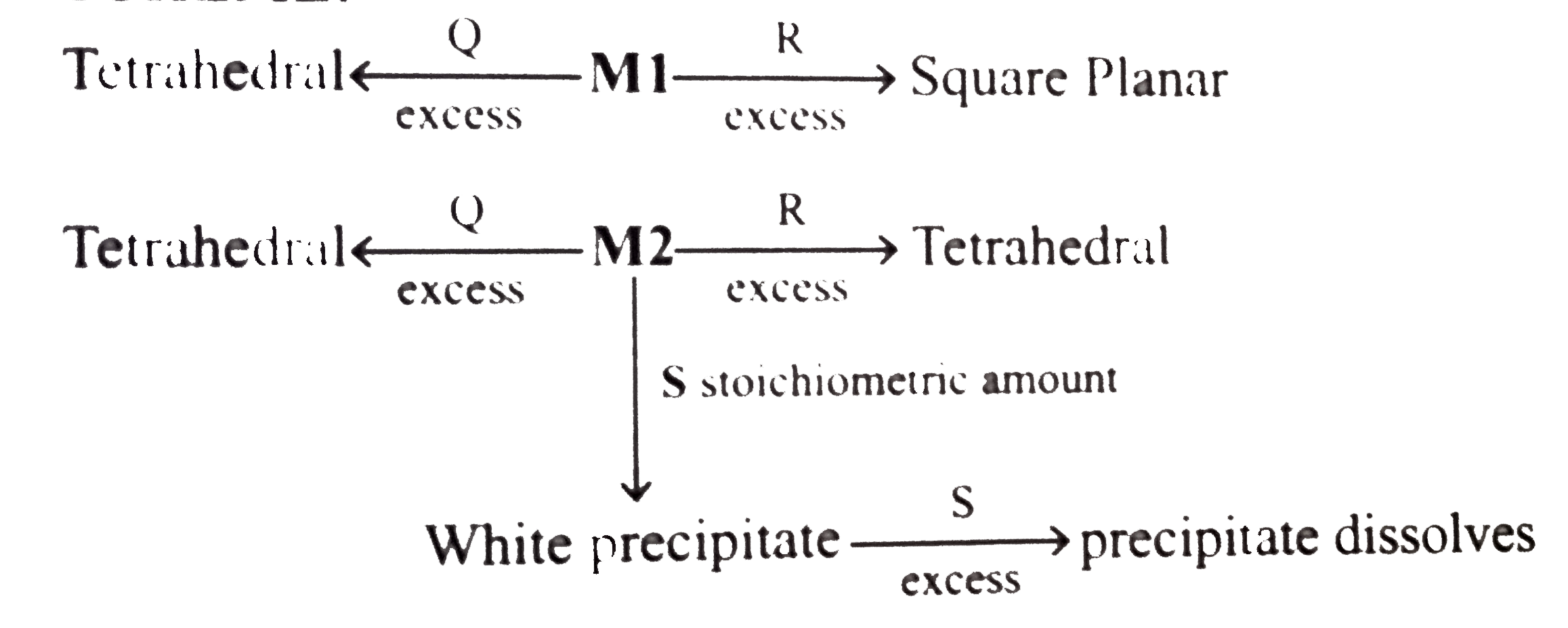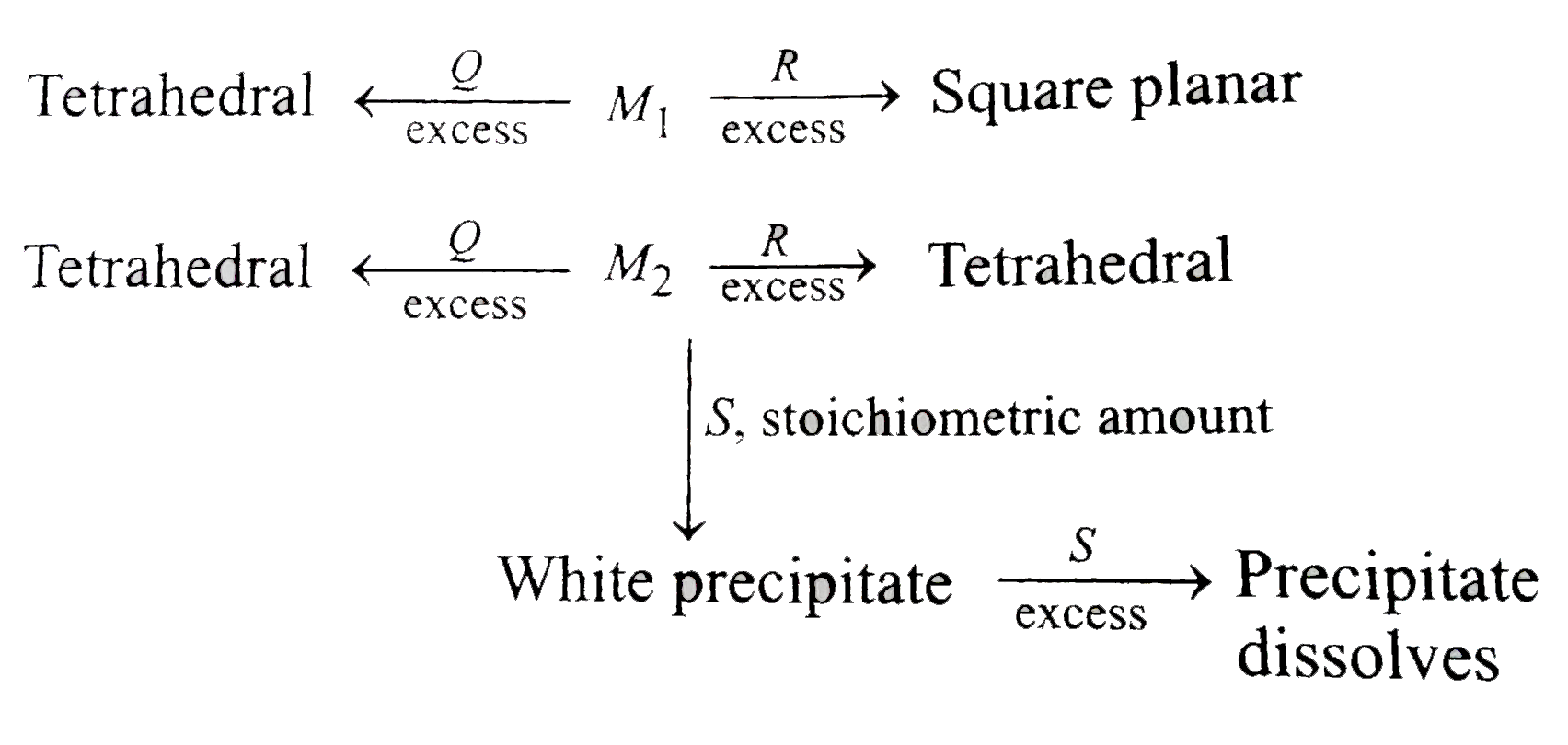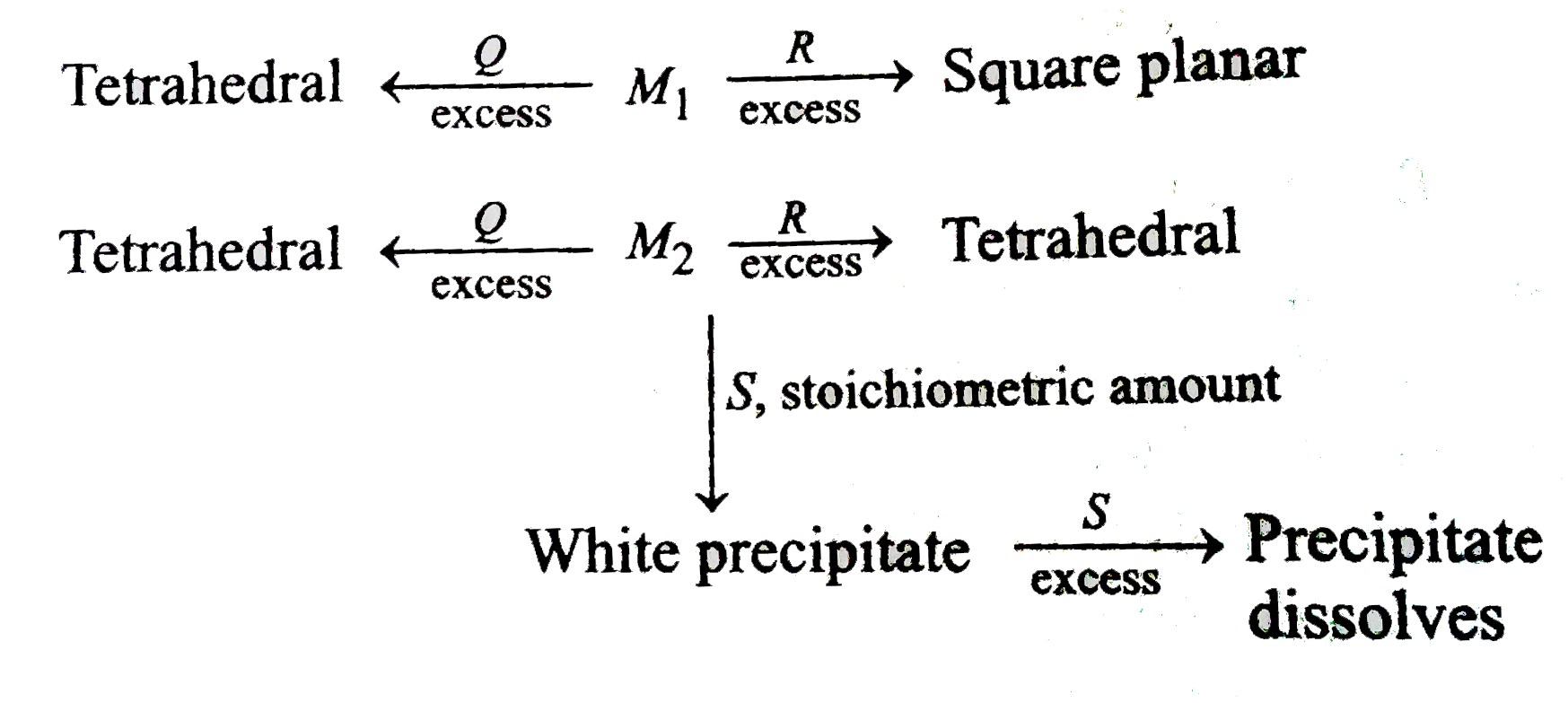An aqueous solution of metal ion MI reacts separately with reagents Q and R in excess to give tetrahedral and square planar complexes, respectively An aqueous solution of another metal ion M2 always forms tetrahedral complexs with theses reagents. Aqueous solution of M2 on reaction with reagent S gives white precipitate which dissolves in excess of S The reactions are summarised in the scheme given below: SCHEME :

what is M2 and S??
A
K4[Fe(CN)6]
B
Na2HPO4
C
K2CrO4
D
KOH
Video Solution
Text Solution
The correct Answer is:D
|
Answer
Step by step video & image solution for An aqueous solution of metal ion MI reacts separately with reagents Q and R in excess to give tetrahedral and square planar complexes, respectively An aqueous solution of another metal ion M2 always forms tetrahedral complexs with theses reagents. Aqueous solution of M2 on reaction with reagent S gives white precipitate which dissolves in excess of S The reactions are summarised in the scheme given below: SCHEME : what is M2 and S?? by Chemistry experts to help you in doubts & scoring excellent marks in Class 12 exams.
Updated on:21/07/2023
Related Playlists
- BOOK - JEE ADVANCED PREVIOUS YEARCHAPTER - JEE ADVANCEDEXERCISE - SECTION - 3 (MATCHING LIST TYPE)3videos
JEE ADVANCED
- BOOK - JEE ADVANCED PREVIOUS YEARCHAPTER - JEE ADVANCEDEXERCISE - Section-18videos
JEE ADVANCED
- BOOK - JEE ADVANCED PREVIOUS YEARCHAPTER - JEE ADVANCEDEXERCISE - PART-2 CHEMISTRY SECTION -1 (ONLY ONE OPTION CORRECT TYPE)10videos
JEE ADVANCED
- BOOK - JEE ADVANCED PREVIOUS YEARCHAPTER - JEE (ADVANCED ) 2020EXERCISE - SECTION -III6videos
JEE (ADVANCED ) 2020
- BOOK - JEE ADVANCED PREVIOUS YEARCHAPTER - JEE ADVANCED 2020EXERCISE - SECTION-36videos
JEE ADVANCED 2020
Knowledge Check
- Question 1 - Select One
An aqueous solution of metal ion M1 reacts separately with reagents Q and R in excess to gie tetrahedral and sqaure planar complexes, respectively. An aqueous solution of another metal ion M2 always forms tetrahedral complexes with these reagents. Aqueous solution of M2 on reaction with reagent S gives white precipitate which dissolves in excess of S. The reaction are summarised in the scheme given below
Scheme

Reagent S isAK4[Fe(CN)6]BNa2HPO4CK2CrO4DKOH - Question 1 - Select One
In Aqueous solution, metal ion M1 reacts separately with reagents Q and R in excess to give tetrahedral and square planar complexes respectively. An aqueous solution of another metal ion M2 always froms tetrahedral complexes with these reagents. Aqueous solution of M2 on reaction with reagent S gives white precipitate which dissolves in excess of S. The reactions are summarized in the scheme given ahead

Reagent S isAK4[Fe(CN)6]BNa2HPO4CK2CrO4DKOH - Question 1 - Select One
An aqueous solution of metal ion M1 reacts separately with reagents Q and R in excess to gie tetrahedral and sqaure planar complexes, respectively. An aqueous solution of another metal ion M2 always forms tetrahedral complexes with these reagents. Aqueous solution of M2 on reaction with reagent S gives white precipitate which dissolves in excess of S. The reaction are summarised in the scheme given below
Scheme

M1,Q and R, respectively areAZn2+,KCN and HClBNi2+,HCl and KCNCCd2+,KCN and HClDCo2+,HCl and KCN - Question 1 - Select One
An aqueous solution of metal ion M1 reacts separately with reagents Q and R in excess to give tetrahedral and square planar complexes, respectively. An aqueous solution of anotherr metal ion M2 always forms tetrahedral complex with these reagents. Aqueous solution of M2 on reaction with reagent S gives white precipitate which dissolves in excess of S. The reactions are summarized in the scheme given ahead.
SCHEME:
Tetrahedral Q←−−excessM1R−−→excess Square planar
TetrahedralQ←−−excessM2R−−→excessTetrahedral ↓S.stoichiometric amount White pptS−−→excess.Precipitate dissolves
Reagent S is:AK4[Fe(CN)6]BNa2HPO4CK2CrO4DKOH - Question 1 - Select One
An aqueous solution of metal ion M1 reacts separately with reagents Q and R in excess to give tetrahedral and square planar complexes, respectively. An aqueous solution of anotherr metal ion M2 always forms tetrahedral complex with these reagents. Aqueous solution of M2 on reaction with reagent S gives white precipitate which dissolves in excess of S. The reactions are summarized in the scheme given ahead.
SCHEME:
Tetrahedral Q←−−excessM1R−−→excess Square planar
TetrahedralQ←−−excessM2R−−→excessTetrahedral ↓S.stoichiometric amount White pptS−−→excess.Precipitate dissolves
M1,Q and R, respectively are:AZn2+,KCN and HCIBNi2+,HCI and KCNCCd2+,KCN and HCIDCo2+,HCI and KCN - Question 1 - Select One
In Aqueous solution, metal ion M1 reacts separately with reagents Q and R in excess to give tetrahedral and square planar complexes respectively. An aqueous solution of another metal ion M2 always froms tetrahedral complexes with these reagents. Aqueous solution of M2 on reaction with reagent S gives white precipitate which dissolves in excess of S. The reactions are summarized in the scheme given ahead

M1, Q and R respectively areAZn2+ , KCN and HClBNi2+ , HCl and KCNCCd2+ , KCN and HClDCo2+ , HCl and KCN - Question 1 - Select One
An aqueous solution containing S2− ions will not give:
AYellow precipitate with the suspension of CdCO3 in water.BBlack precipitate with lead acetate solution.CWhite precipitate with CaCO3 suspension.DPurple colour with sodium thiosulphate solution. - Question 1 - Select One or More
An aqueous solution containing S2− ions will not give:
AA yellow precipitate with the suspension of CdCO3 in waterBBlack precipitate with lead acetate solutionCWhite precipitate with CaCO3 suspensionDPurple colour with sodium thiosulphate solution - Question 1 - Select One
On addition of aqueous NaOH to a salt solution, a white gelatinous precipitate is formed, which dissolves in excess of alkali. The salt solution contains
AChromous ionsBAluminium ionsCBarium ionsDIron ions. - Question 1 - Select One or More
An aqueous solution containing S2− ions will not give:
AYellow precipitate with the suspension off CdCO3 in waterBBlack precipitate with lead acetate solutionCWhite precipitate with BaCl2 solutionDPurple colour with sodium thiosulphate solution

